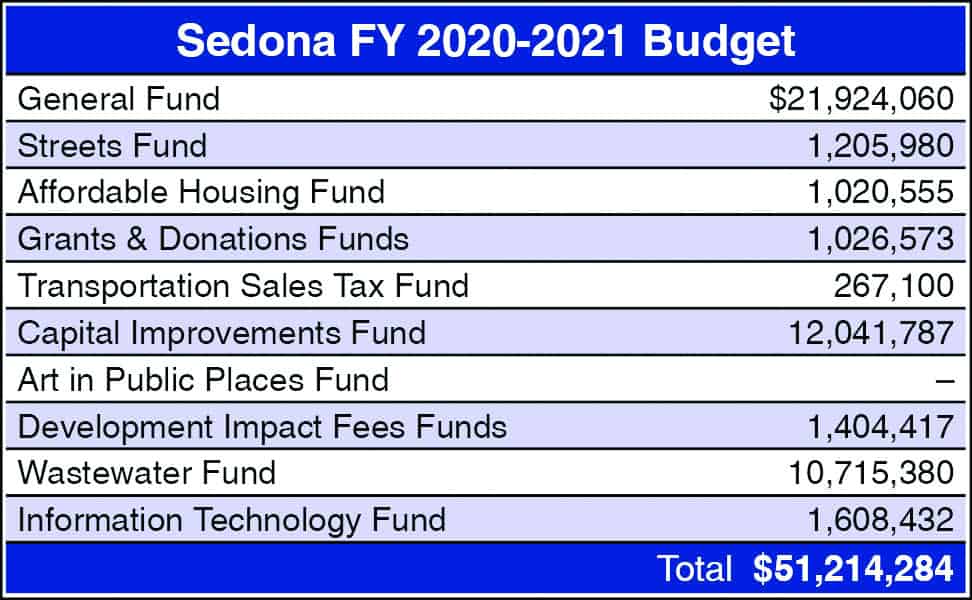With so much uncertainty these days, putting a budget together without the use of a crystal ball to see what the future holds is not an easy task.
Despite the challenges, the Sedona City Council approved the Fiscal Year 2020-21 budget of $51,214,284 on Tuesday, Aug. 11. [See graphic below for budget breakdown]. This year’s budget is $200,000 less that the previous year’s budget, which ended June 30. It’s not anticipated that this year’s spending will come close to that amount, as the city has been as much as 20% under budget in recent years.
But this isn’t a normal year.
“We still don’t know a lot when it comes to COVID-19, but so far we’ve been tracking a little bit better than what our original projections were,” Sedona Finance Director Cherie Wright said. “So, revenues could potentially come in higher.”
With sales and bed tax making up the bulk of the city’s annual budget, the decrease in visitors to the area has a direct impact on the city’s bottom line. Wright said they are estimating an 18% decrease this fiscal year in sales tax compared to Fiscal Year 2019-20 and a 33% drop in bed tax compared to last year.

In April, bed tax was down 91% and sales tax 57% compared to April 2019, which traditionally, along with March, are the busiest months of the year for hotel occupancy in Sedona. After seeing an increase in sales and bed tax the first nine months of last fiscal year prior to COVID-19 — compared to the previous year — the city ended up down 7% in sales tax and 14% in bed tax. That’s due to the fact that spring is the city’s busiest time of the year for tourism.
“For where we’re at, it’s hard to predict what’s going to continue to happen,” Wright said.
In July, when council approved the tentative budget, Wright addressed the fact that the city is looking at as much as a $10 million shortfall this fiscal year as a result of COVID-19 and the subsequent loss of sales and bed tax dollars.
“Arizona law requires that a budget cap be set,” Wright said last month. “The most prudent approach is to set the cap at the highest level expected with room for contingencies. Since no one knows when or how quickly our economy will recover, we need to be prepared for the best-case scenario while planning for the worst-case scenario.”
She said the budget was reduced in many areas, however, it remained pretty much flat in total because of an increase in the capital improvements budget. The capital improvements budget includes numerous projects that many community members have requested move forward. These include the pedestrian crossing at Tlaquepaque, the Forest Road extension, restoration work for the old Ranger Station at the Brewer Road property, Posse Grounds parking improvements and several shared-use paths.
For many years, the city has had surpluses over and above the required reserve balances, Wright said. This has been a result of the strong economy prior to COVID-19 and conservative spending practices.
“These surpluses contribute to balancing the budget for FY 2021 with a projection of $16 million in surpluses still remaining at the end of the fiscal year,” she said in July. “The city has proactively restricted its current spending to only the most essential items, which has created savings that have helped offset the reduction of revenues.
“Also, revenues have been trending a little higher than the initial projections. Spending will continue to be restricted until more is known about the future impacts to the city’s revenues to ensure the city’s actual financial position remains positive.”